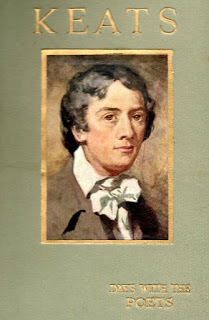Death of John Keats
 John Keats
Loretta reports:
John Keats
Loretta reports:William Hone , the author of Hone’s Every-Day Book (which I frequently cite) wasn’t shy about giving his opinions, a trait that landed him in court more than once.
I was aware of Byron’s having joked that a bad review finished Keats off. This entry in the Every-Day Book, though, was rather more touching, and very much in Hone’s plain-spoken, pugnacious spirit. Any writer who’s suffered a nasty review can testify to the unpleasantness of the experience. It has certainly aided and abetted writer’s block in some cases; aroused defiance in others. Has it ever hastened an author’s death? I don’t know. But I promise you that it has led to some writers' fantasizing about hastening the critic’s demise.
In fact, though it’s generally agreed that Keats died of consumption (tuberculosis), there is debate about the role mercury played in shortening his life. He has written that he took it, so that’s not disputed. But why is another question. Some believe he took it to treat a venereal infection ; others point out that mercury was used to treat other ailments, and Mr. Keats's health issues were complex.
~~~February 23.Chronology.1821. John Keats, the poet, died. Virulent and unmerited attacks upon his literary ability, by an unprincipled and malignant reviewer, injured his rising reputation, overwhelmed his spirits, and he sunk into consumption. In that state he fled for refuge to the climate of Italy, caught cold on the voyage, and perished in Rome, at the early age of 25. Specimens of his talents are in the former volume of this work. One of his last poems was in prospect of departure from his native shores. It is an
Ode to a Nightingale.My heart aches, and a drowsy numbness pains My sense, as though of hemlock I had drunk, Or emptied some dull opiate to the drains One minute past, and Lethe-wards had sunk; Tis not through envy of thy happy lot, But being too happy in thine happiness,— That thou, light-winged Dryad of the trees, In some melodious plot Of beechen green, and shadows numberless, Singest of summer in full-throated ease. ... *
This ode was included with "Lamia, Isabella, the Eve of St. Agnes, and other Poems,” by John Keats, published by Messrs. Taylor and Hessey, who, in an advertisement at the beginning of the book, allude to the critical ferocity which hastened the poet's death. —Hone’s Every-Day Book Vol II (originally published 1827)~~~
*Please click on above the link to the Every-Day Book for the full poem.
Image: Cover of May Clarissa Gillington Byron's A Day with Keats (1913) courtesy Project Gutenberg.
Published on February 22, 2016 21:30
No comments have been added yet.



